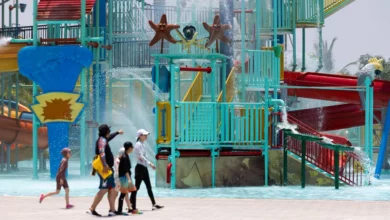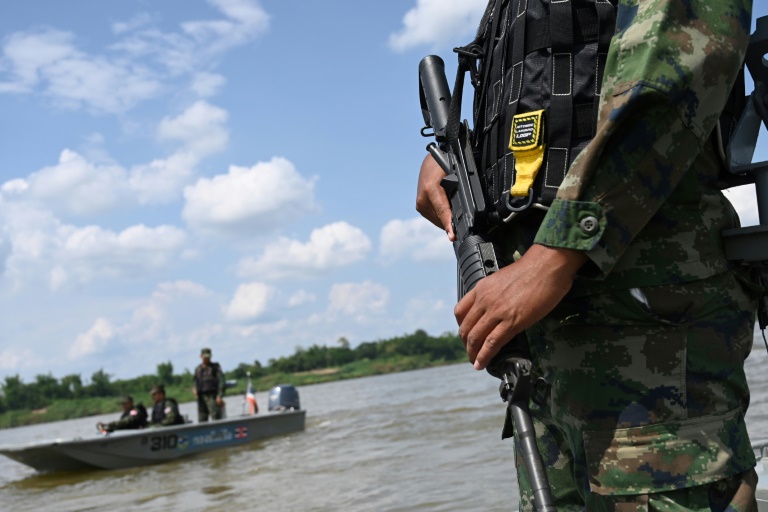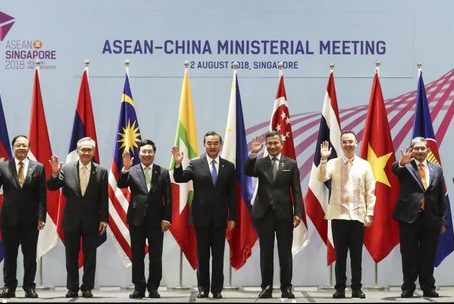The clock on the wall of Luang Prabang’s northern bus terminal read 10:00 a.m.
“What time will the bus leave?” I asked the clerk.
“Bus leaves 9 o’clock,” the visibly jaded, or perhaps organically sedated, Laotian responded as he pointed to my right. “Bus to Nong Kiaw there.”
A few older women squatted around a covered pick-up truck, eating pinches of sticky rice out of woven containers. Men milled about, smoking cigarettes and slowly packing boxes on the vehicles’ roof.
Several other pick-up trucks — called sungthaws throughout Southeast Asia — dotted the scene. A few actual buses were also present, mostly heading for the Chinese border several hundred kilometers north or to the capital of Laos, Vientiane, a roughly equal distance in the opposite direction. Regardless of the destinations, no driver, no assistant (i.e. money collector, baggage handler), no passenger, and no hawker manning the stalls lining the perimeter of the terminal seemed to be consumed by any type of initiative, let alone urgency.
For decades, Southeast Asia has drawn droves of the world’s tourists. Due to its natural beauty, hospitable people, and the intrigue of Buddhist culture, no region in the world is more heavily trafficked by backpackers. Years ago, Bangkok established itself as the Mecca of shoestring travel and has yet to relinquish that title.
Thailand is cosmopolitan and rife with immaculate beaches. Cambodia is war-torn. Vietnam is chaotic and Myanmar is suppressed. Marginalized by its neighbors, Laos is forgotten. As a by-product, Southeast Asia’s sole land-locked country has preserved pristine natural landscapes, authentic culture and possibly the most relaxed, jovial and extraordinarily slow-moving people on the globe.
Northern Laos, a network of unspoiled rivers and dramatic mountain ranges nestled between remote areas of surrounding Thailand, Myanmar, China and Vietnam remains particularly isolated and, for that reason, particularly captivating.
But Laos is not all smiles and towering peaks. It’s not strictly tranquility and sticky rice. Laos laments an ugly contemporary history of colonial conquest and internecine strife.
After briefly gaining independence in 1945 following the Japanese World War II occupation, the French seized the territory with minimal exertion. Laos was then granted full independence, implementing a constitutional monarchy in 1954 after a five-year stint with semi-autonomy.
The wake of independence declaration brought on a bloody and enduring civil war lasting more than two decades. During this period, the war in neighboring Vietnam also spilled over the country’s borders. The Americans strove to eliminate the supply routes of the Ho Chi Minh Trail and relative sanctuary the North Vietnamese enjoyed in Northern Laos.
The country of merely six and a half million people boasts few superlatives on the international stage. One of which, however, is the fact that Laos witnessed the most carpet-bombing during the decade long US military involvement in Southeast Asia. The sheer amount of ordnance in the aerial bombardments, military experts say, exceeded the amount discharged from aircraft during World War II. American officials for decades denied their bombs — which wreaked havoc and death on innocent people forced to seek refuge in vast caves for years on end — dropped within the Laotian border.
When the conflict ceased, the Communist Pathet Lao movement — firmly backed by the North Vietnamese — ascended to power, abolishing the monarchy and installing a single-party socialist republic. A presidency, premiership and rubber stamp national assembly belonging to the Lao People’s Revolutionary Party continues to run Lao People’s Democratic Republic.
Eleven a.m. rolled around and an increasing number of Laotians began boarding our sungthaw. The seats eventually filled and we departed Luang Prabang — a city in which thousands of monks stream to the streets at dawn to collect alms — bus terminal packed to capacity a mere two and a half hours after the scheduled time.
No one minded in least. No one appeared in a rush. At no point in time was there any visible pressure leveled toward the driver to get our idle selves out of town. In Laos, it becomes quickly evident that time is irrelevant. Things happen when they happen and people are content with that. And in order to enjoy your time in such a country, you are quickly coerced into being equally accepting.
Leaving the city, we passed the confluence of the Nam Shan and mighty Mekong rivers. The monastery resting atop Luang Prabang’s Phu Si Hill, with its golden spires and reclining Buddhas, dominated the skyline to our rear.
No available space existed on the wooden planks, seats for the five-hour trip northeast to Nong Kiaw for fifteen passengers, but as we reached a few kilometers outside of town two families totaling twelve people flagged down the bus. The bus driver stopped. Deliberation ensued. We departed. We stopped. The families were waved on, racing the 100 meters to our current location down the road.
I was intrigued to see the space they intended to occupy. The middle of the pickup became their home, sitting on rice bags, boxes, healthy men and elderly grandmothers alike. With the new passengers, mostly women and young kids, the ride became instantaneously intimate. Smiles abounded. Chicken, sticky rice and exotic fruits were distributed amongst ourselves.
In the next hour or so, in an effort to ensure there was no possibility of piling in additional bodies, we picked up a few young Laotians, garbed in camouflage and looking battle-hardened, as if they had recently emerged from the 1972 conflict ridden jungle. They hung off the back as the driver spirited us north, nearly careening off every corner.
But no high occupancy rate could steal the beauty of this region. We followed the Nam Au River for a large segment of the ride — a body of water serenely middle-sized hosting massive boulders, gentle rapids and droves of water buffalo lounging in the water, soaking in the midday sun.
Towering limestone peaks filled the landscape, jutting out of the earth in dramatic and uniquely monolithic fashion. Several-hundred-meter sheer cliffs marked the sides of nearly all the mountains. Where there was room for vegetation, verdant monochromatic jungle, vine and fern ridden, extended in every direction.
Several hours in to the drive, a young boy began vomiting his breakfast. Led by the elderly women, the crowd erupted in applause. It appeared a standing ovation would have followed had we been able to maneuver at all, let alone stand up. Perplexed, I for some reason felt the inclination to partake and did so. The boy continued to throw up for minutes and we continued to laugh and applaud.
Shortly thereafter, a family of a few kids and a grandmother disembarked. One child fell off the back of the sungthaw and face planted. The grandmother laughed again, declining to extend a helpful hand. She paid the money collector and walked away. The child got up, composed himself and followed.
I suppose these instances in a way best depict Laotian mentality. Despite being on one of the poorest countries globally in terms of GDP — not necessarily always a good barometer on wealth, particularly with overwhelming agrarian societies — life, according to Laotians, is okay. Life is actually pretty good. Vomit. You’ll get over it.
And so despite the disgorging and claustrophobia, we reach Nong Kiaw. A bridge connecting both sides of the Nam Au is far and away the most industrious image for miles. The sleepy town of a thousand hosts bungalows for US$5 along the banks of the river, cheap food stalls where cured pork is readily available, and a perfect place for swimming along a river that snakes through two prodigious peaks.
Spend a few days in Nong Kiaw. The network of caves to the east of town harbored Laotians fleeing American bombs from 1964 to 1973. The community that assembled there designated certain areas for the medical ward, the bank, political gathering, and all necessities of displaced life. Rent a bike. Tour the area. The surrounding landscapes are nothing short of magnificent.
But the ultimate glance into the balance of Northern Laotian life and backpacker heaven rests 20 kilometers north.
Muang Neua Noi is a paragon of unadulterated natural beauty, remote Laotian village life and easy travelling. Only accessible by river (that is unless you want to bushwhack guerrilla warfare style) the town of a few hundred remains pristine despite its status as a prime travelling destination.
Every bungalow boasts a view of the river and the overlapping mountain ranges of the Nam Au’s other bank. Caves dot the surrounding area. Small villages are within walking distance through lush rice paddies and jungle. Multiple day trips treks can easily be arranged. Or try you luck at spear gun fishing. I did for hours. I caught nothing.
Or grab a hammock and don’t leave it for days. Read books and regale other people with your incredibly unique, taxing and harrowing travel stories. That seems to be the thing to do in Southeast Asia. Among its many other qualities, there is no shortage of shoestring bravado.




